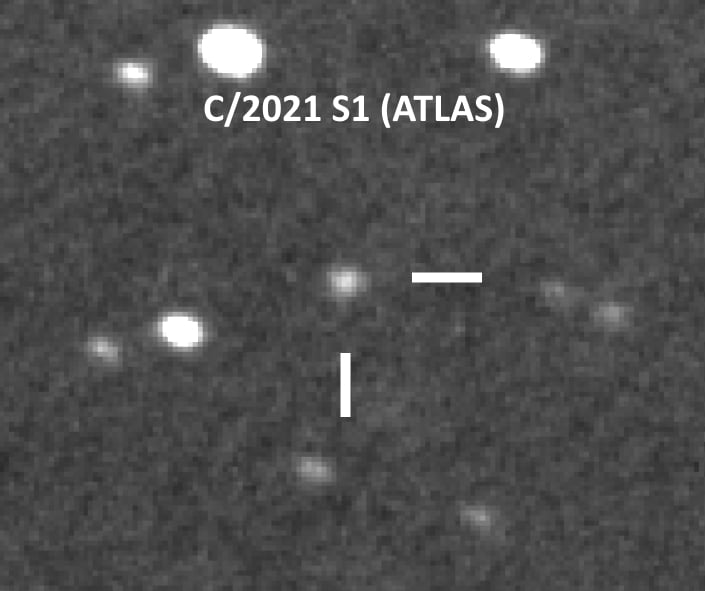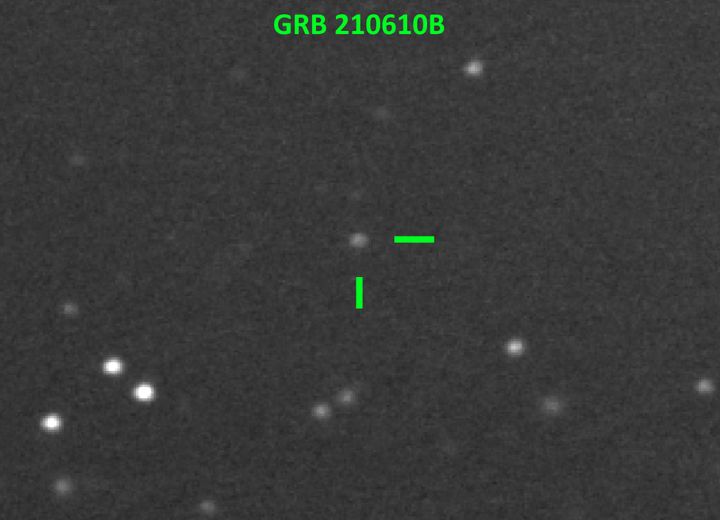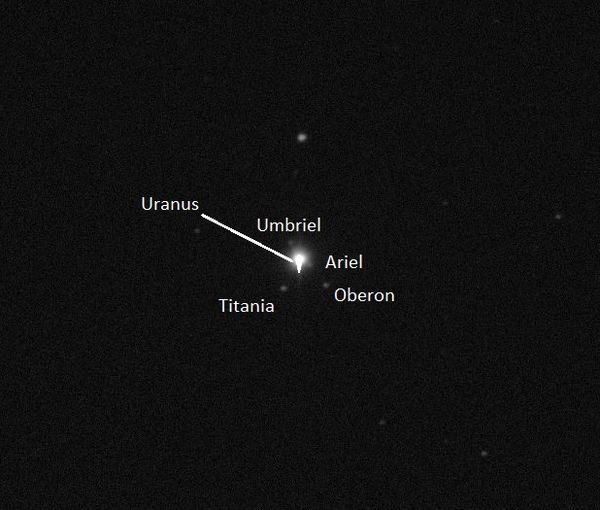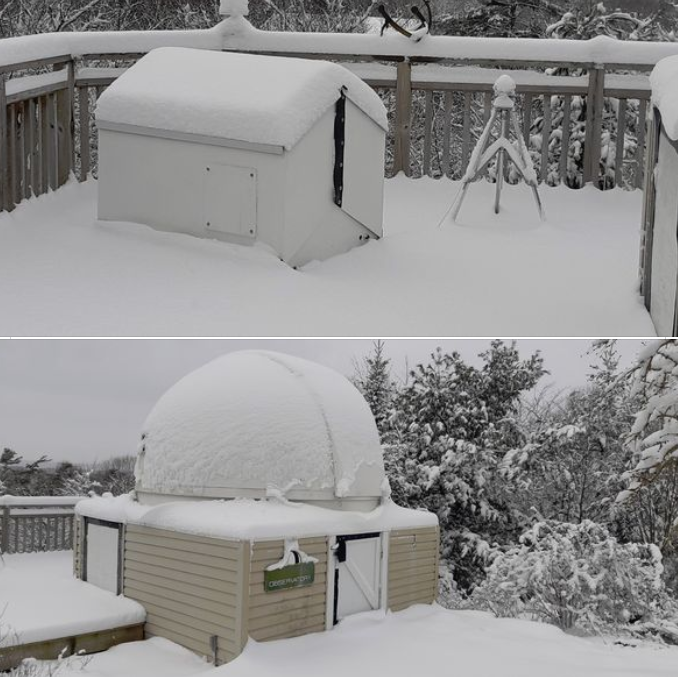October - Observations of Comet's and Asteroids
Confirming observations by ARO observer Filipp Romanov of comets and asteroids were made the past two months, remotely using the ARO:
2021 QA (A10A7uQ name on the NEO Confirmation Page - NEOCP - of the Minor Planet Center): near-Earth asteroid from the Amor group. First observed at ATLAS-HKO, Haleakala (T05) on 2021-08-16. Absolute magnitude = 20.4. Closest approach to the Earth was on August 21, 2021, at ≈ 69 lunar distances (LD).
He observed it on August 17, 2021 (on the date of the 12th anniversary of the start of his study of astronomy by self-education), results of his astrometric observations were published in the Minor Planet Electronic Circular (MPEC) https://minorplanetcenter.net/mpec/K21/K21Q17.html about discovery of the asteroid. A stacked image (20 photos x 20 sec.) is below:

2021 RA10 (A10Bajq name on the NEOCP): near-Earth asteroid from the Apollo group. First observed at ATLAS-HKO, Haleakala on 2021-09-11. Absolute magnitude = 25.4. On September 4, 2021, it passed within ≈ 1.9 LD of Earth.
He observed it on September 12, his astrometric data was published in the discovery MPEC: https://minorplanetcenter.net/mpec/K21/K21RR1.html I am attaching animation: 4 photos x 60 sec.
C/2021 S1 (ATLAS) (with A10BpPq name on the PCCP - Possible Comet Confirmation Page): comet with orbital eccentricity value near 1, perihelion date is March 2022. First observed at ATLAS-HKO, Haleakala on 2021-09-27. On October 1, 2021, photos of new comet were taken: He did astrometric measurements and estimated the coma diameter (5 arcsec.). This data was published (on October 3) in the MPEC 2021-T21 https://minorplanetcenter.net/mpec/K21/K21T21.html about discovery of this comet. A stacked image 24x60 sec. (unfiltered) is below:

2021 TH12 (C2E6M31 name on the NEOCP): near-Earth asteroid from the Apollo group. First observed at Catalina Sky Survey (703) on 2021-10-11. Absolute magnitude = 22.8. On October 7, 2021, it passed at ≈ 19 LD from the Earth. He observed it on October 12, results of his astrometric measurements were published: https://minorplanetcenter.net/mpec/K21/K21TN7.html
2021 TC21 (Sar2559 name on the NEOCP): near-Earth asteroid from the Apollo group. First observed at GINOP-KHK, Piszkesteto (K88) on 2021-10-15. Absolute magnitude = 26.4. On October 15, 2021, it passed at ≈ 5.5 LD from the Earth. He observed this faint asteroid on October 16, 2021: https://minorplanetcenter.net/mpec/K21/K21U08.html
June 22 - GRB 210619B
Observation of the optical afterglow of gamma-ray burst GRB 210619B from ARO. Long-duration GRB 210619B was detected by the Swift Burst Alert Telescope at 23:59:25 UT on June 19, 2021. The peak count rate was ~100,000 counts/sec (15-350 keV); for comparison: the peak count rate of the recent GRB 210610B was ~11,000 counts/sec (15-350 keV). Redshift of 1.937 was reported in the GCN circular #30272 https://gcn.gsfc.nasa.gov/gcn3/30272.gcn3 with information: "GRB 210619B will likely be among the most energetic GRBs" and "the initial prompt emission spike is extremely luminous, and we expect the afterglow to be among the most luminous prompt flashes ever detected".

On June 20, the weather was cloudy for shooting at ARO, but after a day, on June 21 (on the summer solstice, on the shortest night of the year), the sky was clear. Eight images were obtained with a total exposure of 100 minutes with the Rc filter; an optical afterglow with a magnitude of about 20 is clearly visible on the stacked image.
Photometric measurement was published in the circular #30305 of the Gamma-ray Coordinates Network: https://gcn.gsfc.nasa.gov/gcn3/30305.gcn3
(contributed by ARO/BGO observer Filipp Romanov)
June 12 - GRB 210610B
Observations of optical afterglow of gamma-ray burst GRB 210610B were made on the BGO and ARO telescopes on June 11, 2021.
This long GRB was detected by the Swift Burst Alert Telescope on 19:51:27 UT on June 10, 2021 (redshift value z=1.1345 has been published later). At 02:01:17, shooting of ARO began, and at 02:05:45 imaging at the BGO began. As a result, 6 photographs were obtained with different filters, which clearly showed an optical afterglow with a magnitude of about 17.5 magnitudes. Photometric measurements were published in circular #30228 of the Gamma-ray Coordinates Network:
Below is a stacked image with a total exposure of 67 minutes.
(contributed by ARO/BGO observer Filipp Romanov)

June 2
A new Observatory Statistics page has been added that provides tables and charts of various statistics by month, year, or all time, extracted from the observatory's databases.
May 5
ARO Observer, Filipp Romanov, reports the following observations which aided in the discovery of a new near-earth minor planet!
Good news: the first Minor Planet Electronic Circular about the discovery of a Near-Earth Object with observations from ARO was published.
On May 2, 2021, I made astrometric measurements from ARO photographs of an asteroid A10WSDY (posted on the NEO Confirmation Page). Despite the slight defocusing and haze in the sky during shooting, I selected two images with better visibility of the object, and sent the measurements to the MPC. As a result, this was published minorplanetcenter.net/mpec/K21/K21J16.html in the MPEC 2021-J16 with the assignment of the asteroid designation 2021 HC3.
The asteroid has a size of 95-300 meters and on May 4, 2021, on 18:05 UT, it will approach the Earth at 18.5 lunar distances. At perihelion, the asteroid is closer to the Sun than the orbit of Mercury; at aphelion, it is farther than the orbit of Mars.
By the way, on May 3, the first MPEC about comet observations - with my astrometric measurements (of comet 29P) from ARO - was published minorplanetcenter.net/mpec/K21/K21J28.html

With best regards, Filipp Romanov
March 5
Abbey Ridge Observatory took this movie of asteroid (99942) Apophis on the night of March 5 as it whizzed past Earth. It was requested using Twitter by Russian observer Filipp Romanov. It was about 16.9 million km distant. The exposures were 20 seconds over about 30 minutes. The asteroid is the moving star near the centre of the movie. Apophis' claim to fame is that it will make a close approach to Earth on April 13, 2029, when it comes to within a distance of around 31,600 kilometres.
February 21 - Uranus
On a lark, I requested an image of Uranus to try to see some of its moons - here are 4 of them!

January 23 - We get snow occasionally at ARO and adjacent MRO!

January and February
Some minor repairs and upgrades were done. The servo controller was replaced with a SiTech Servo II along with new Losmandy motors. The USB hubs were also replaced due to some reliability issues and the telescope power supply was replaced.
The robotic software has been updated to match the other related observatories - MRO and BGO.
